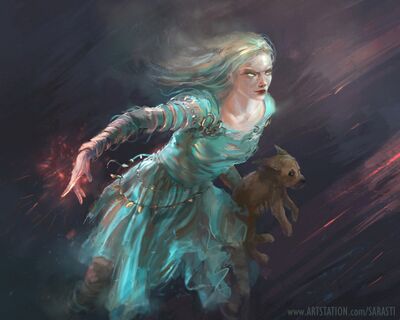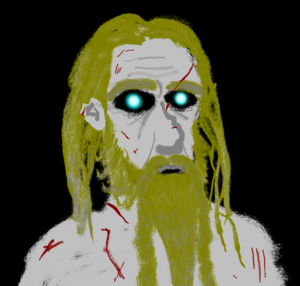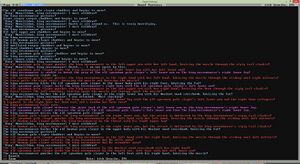- v50 information can now be added to pages in the main namespace. v0.47 information can still be found in the DF2014 namespace. See here for more details on the new versioning policy.
- Use this page to report any issues related to the migration.
Difference between revisions of "Intelligent undead"
m (→Powers) |
|||
| Line 51: | Line 51: | ||
* It is unknown if a creature brought back to life this way can be raised as undead again. | * It is unknown if a creature brought back to life this way can be raised as undead again. | ||
| − | *In adventure mode, it seems to be possible to animate mangled corpses as intelligent undead. Whether this is a bug, or an intentional side effect of using more powerful magic is unclear. | + | *In adventure mode, it seems to be possible to animate mangled corpses as intelligent undead. Whether this is a bug, or an intentional side-effect of using more powerful magic is unclear. |
== See also == | == See also == | ||
Revision as of 12:32, 3 September 2020
v53.03 · v0.47.05 This article is about the current version of DF.Note that some content may still need to be updated. |
| This article is a stub. You can improve the article by expanding it. |
| This page contains information only relevant to DF 0.47.01 and newer. Most or all of this information does not apply to previous versions. Older saves from previous versions in the DF2014 release cycle are still compatible with this version. |

Intelligent undead Ñ is a generalized name for all undead night creatures that are sentient (not zombies), yet don’t fit into the molds for vampires, necromancers, ghosts or mummies.
Intelligent undead are former historical figures, raised by necromancers to serve as lieutenants in their undead armies. Unlike zombies, intelligent undead retain much of their original personality once revived. This includes loyalty, so do not attempt to raise an enemy you have slain in adventure mode as an intelligent undead - they will remember they're your foe and will attack you.
Intelligent undead all belong to a type, dependent on the secret known by the one who raised them. Each type is assigned a unique name and a set of magic powers, making no two types truly alike.
They are relatively common - if you set your tavern to be open to all visitors, you are very likely to host a few guests of the intelligent undead variety. Despite their scary sounding names, these are not hostile and will behave as any guest would.
If you happen to have a necromancer among your citizens, they may very well revive some of your recently fallen dwarves as intelligent undead if they are nearby and involved in combat. Unlike run-of-the-mill zombies, they will not be hostile and will eventually re-petition for citizenship in your fortress. Intelligent undead are impervious to stress and emotions - any event in their Thoughts and Preferences screen will cause them to "not feel anything". However, they inevitably become Distracted due to unmet needs, despite performing most of the jobs (Worship, Socialize, Read etc.) that should fulfill those needs. Intelligent undead children are immune to this distraction.
They can still make friends and be involved in relationships and will retain the ones they had when they died. They do not need to eat, drink, or sleep and can function normally despite very severe damage, such as a brain and skull "mangled beyond recognition," providing excellent practice for your medical dwarves. They do not age, do not reproduce, do not gain or rust physical attributes, and count as [NOT_LIVING] so other undead will be neutral to them. They also have many of the immunities undead have, such as [NOEXERT], [NOPAIN], [NOBREATHE], [NOSTUN], [NONAUSEA], [NO_DIZZINESS], [NO_FEVERS], [PARALYZEIMMUNE], [NOFEAR], [NO_THOUGHT_CENTER_FOR_MOVEMENT], [NO_CONNECTIONS_FOR_MOVEMENT] and [EXTRAVISION]. They also cannot bleed to death. This, in addition to the magic powers granted to them when they were raised, makes them very useful assets to your fortress.
Necromancers may also raise invaders as intelligent undead. They may be hostile, even against the necromancer who created them, or marked as "Friendly" and sit around doing nothing.
Like all undead, intelligent undead dwarves cannot enter trances anymore, and intelligent undead gremlins are no longer [MISCHEVOUS].
Naming
The phrase ”intelligent undead” does not actually appear within the game. Instead, each kind of intelligent undead receives a procedurally-generated name, composed of two parts. The first part alludes to it being undead (e.g. ”putrid”, ”risen”, ”grave”) or its nature as a night creature (e.g. ”night”, ”grim”). The second part is always a noun, and sometimes describes it as being undead (e.g. ”zombie”, ”ghoul”) but just as often, simply makes it sound threatening (e.g. ”one”, ”slayer”, ”butcher”, ”stalker”).
Powers
Each type of intelligent undead is given a set of 1-4 magic powers, with the possibility of acquiring more if they are raised multiple times by different necromancers. Undead may target themselves with their own powers, which has niche applications. The following powers have been reported:
- Blisters - Causes the target to grow blisters all over their bodies. Does not hamper fighting ability, making it mostly useless in a fight.
- Dizziness - The target is affected by dizziness, possibly inconveniencing them in combat.
- Pain - The target is afflicted with pain, to the point of being stunned by it.
- Suffocate - Causes the target to become winded. Does not last long enough to kill by suffocation, but will make the target take longer to take actions.
- Bleeding - The target suffers blood damage across the body. Can stack, leading to death by blood loss if multiple undead use it on the same target.
- Sicken - The target becomes nauseated and starts vomiting, leaving them vulnerable.
- Blind - The target loses their sight temporarily. Creatures with
[EXTRAVISION]are immune to this power. - Rot - A random body part of the target will suffer minor necrosis. Can lead to extreme fun if the body part ends up being your adventurer's eyes.
- Paralysis - The target is completely paralyzed. Generally leads to near-instant death in most creatures, as paralysis of the diaphragm leads to suffocation.
- Raise Fog - The undead changes the weather to create a temporary fog, limiting vision.
- Ice Bolt - The undead launches a sharpened bolt of ice at the target, causing varying physical harm.
- Vanish - The undead immediately enters stealth, becoming invisible. Players are unable to retaliate against the undead's attacks, due to not being able to target them, but may hit them with thrown items. Creatures with
[EXTRAVISION]can see the undead normally, invalidating the power. - Propel Away - The undead blasts the target with force, launching them away from it. Effect varies on the foe's weight; smaller creatures can be seriously injured if they impact with a surface, while heavier targets can resist or flat-out shrug off the blow. Can be used to free the undead from a grapple.
Notes and exploits

Art by Nogoodgames
- It is possible for a civilised intelligent undead to turn into a ghost. In order to be ghostified, the creature needs to leave the map. Assigning the undead to a squad and sending it on raids seems to do the trick, as eventually, the intelligent undead's ghost will rise. The risen ghost will not be interactable, but will still be part of the military.
- This behaviour can be exploited further to resurrect the undead back into its original creature form. Here's how to do it: keep the undead's ghost in a squad, and send this squad on another mission. While the squad is off-map, engrave a memorial slab to the ghost and place it down - when the squad comes back, your undead should now be alive, and its skills will have persisted.
- It is unknown if a creature brought back to life this way can be raised as undead again.
- In adventure mode, it seems to be possible to animate mangled corpses as intelligent undead. Whether this is a bug, or an intentional side-effect of using more powerful magic is unclear.
